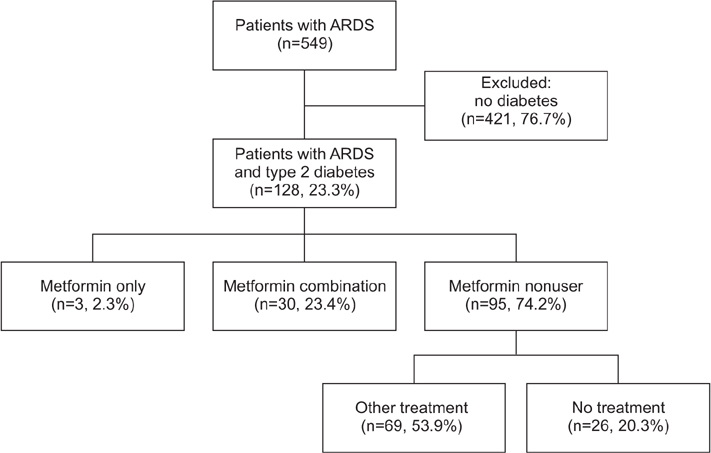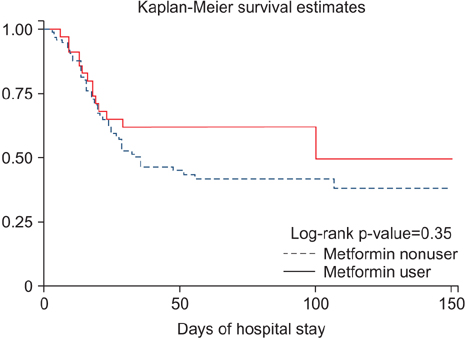Tuberc Respir Dis.
2017 Jul;80(3):296-303. 10.4046/trd.2017.80.3.296.
Effect of Preadmission Metformin Use on Clinical Outcome of Acute Respiratory Distress Syndrome among Critically Ill Patients with Diabetes
- Affiliations
-
- 1Division of Pulmonary and Critical Care Medicine, Department of Internal Medicine, Seoul National University Hospital, Seoul National University College of Medicine, Seoul, Korea. sangmin2@snu.ac.kr
- KMID: 2385046
- DOI: http://doi.org/10.4046/trd.2017.80.3.296
Abstract
- BACKGROUND
Acute respiratory distress syndrome (ARDS) is related to high mortality and morbidity. There are no proven therapeutic measures however, to improve the clinical course of ARDS, except using low tidal volume ventilation. Metformin is known to have pleiotropic effects including anti-inflammatory activity. We hypothesized that pre-admission metformin might alter the progress of ARDS among intensive care unit (ICU) patients with diabetes mellitus (DM).
METHODS
We performed a retrospective cohort study from January 1, 2005, to April 30, 2005 of patients who were admitted to the medical ICU at Seoul National University Hospital because of ARDS, and reviewed ARDS patients with DM. Metformin use was defined as prescribed within 3-month pre-admission.
RESULTS
Of 558 patients diagnosed with ARDS, 128 (23.3%) patients had diabetes and 33 patients were treated with metformin monotherapy or in combination with other antidiabetic medications. Demographic characteristics, cause of ARDS, and comorbid conditions (except chronic kidney disease) were not different between metformin users and nonusers. Several severity indexes of ARDS were similar in both groups. The 30-day mortality was 42.42% in metformin users and 55.32% in metformin nonusers. On multivariable regression analysis, use of metformin was not significantly related to a reduced 30-day mortality (adjusted β-coefficient, −0.19; 95% confidence interval, −1.76 to 1.39; p=0.816). Propensity score-matched analyses showed similar results.
CONCLUSION
Pre-admission metformin use was not associated with reduced 30-day mortality among ARDS patients with DM in our medical ICU.
MeSH Terms
Figure
Reference
-
1. ARDS Definition Task Force. Ranieri VM, Rubenfeld GD, Thompson BT, Ferguson ND, Caldwell E, et al. Acute respiratory distress syndrome: the Berlin Definition. JAMA. 2012; 307:2526–2533.2. American Diabetes Association. Standards of medical care in diabetes: 2013. Diabetes Care. 2013; 36:Suppl 1. S11–S66.3. Kirpichnikov D, McFarlane SI, Sowers JR. Metformin: an update. Ann Intern Med. 2002; 137:25–33.4. Nyenwe EA, Jerkins TW, Umpierrez GE, Kitabchi AE. Management of type 2 diabetes: evolving strategies for the treatment of patients with type 2 diabetes. Metabolism. 2011; 60:1–23.5. Tsoyi K, Jang HJ, Nizamutdinova IT, Kim YM, Lee YS, Kim HJ, et al. Metformin inhibits HMGB1 release in LPS-treated RAW264.7 cells and increases survival rate of endotoxaemic mice. Br J Pharmacol. 2011; 162:1498–1508.6. Grant PJ. Beneficial effects of metformin on haemostasis and vascular function in man. Diabetes Metab. 2003; 29(4 Pt 2):6S44–6S52.7. Zmijewski JW, Lorne E, Zhao X, Tsuruta Y, Sha Y, Liu G, et al. Mitochondrial respiratory complex I regulates neutrophil activation and severity of lung injury. Am J Respir Crit Care Med. 2008; 178:168–179.8. Tsaknis G, Siempos II, Kopterides P, Maniatis NA, Magkou C, Kardara M, et al. Metformin attenuates ventilator-induced lung injury. Crit Care. 2012; 16:R134.9. Christiansen C, Johansen M, Christensen S, O'Brien JM, Tonnesen E, Sorensen H. Preadmission metformin use and mortality among intensive care patients with diabetes: a cohort study. Crit Care. 2013; 17:R192.10. Murray JF, Matthay MA, Luce JM, Flick MR. An expanded definition of the adult respiratory distress syndrome. Am Rev Respir Dis. 1988; 138:720–723.11. Moss M, Guidot DM, Steinberg KP, Duhon GF, Treece P, Wolken R, et al. Diabetic patients have a decreased incidence of acute respiratory distress syndrome. Crit Care Med. 2000; 28:2187–2192.12. Hudson LD, Milberg JA, Anardi D, Maunder RJ. Clinical risks for development of the acute respiratory distress syndrome. Am J Respir Crit Care Med. 1995; 151(2 Pt 1):293–301.13. Iscimen R, Cartin-Ceba R, Yilmaz M, Khan H, Hubmayr RD, Afessa B, et al. Risk factors for the development of acute lung injury in patients with septic shock: an observational cohort study. Crit Care Med. 2008; 36:1518–1522.14. Ansari G, Mojtahedzadeh M, Kajbaf F, Najafi A, Khajavi MR, Khalili H, et al. How does blood glucose control with metformin influence intensive insulin protocols? Evidence for involvement of oxidative stress and inflammatory cytokines. Adv Ther. 2008; 25:681–702.15. Paiva M, Riksen NP, Davidson SM, Hausenloy DJ, Monteiro P, Goncalves L, et al. Metformin prevents myocardial reperfusion injury by activating the adenosine receptor. J Cardiovasc Pharmacol. 2009; 53:373–378.16. Salpeter SR, Greyber E, Pasternak GA, Salpeter EE. Risk of fatal and nonfatal lactic acidosis with metformin use in type 2 diabetes mellitus. Cochrane Database Syst Rev. 2010; (4):CD002967.17. Chan NN, Brain HP, Feher MD. Metformin-associated lactic acidosis: a rare or very rare clinical entity? Diabet Med. 1999; 16:273–281.



